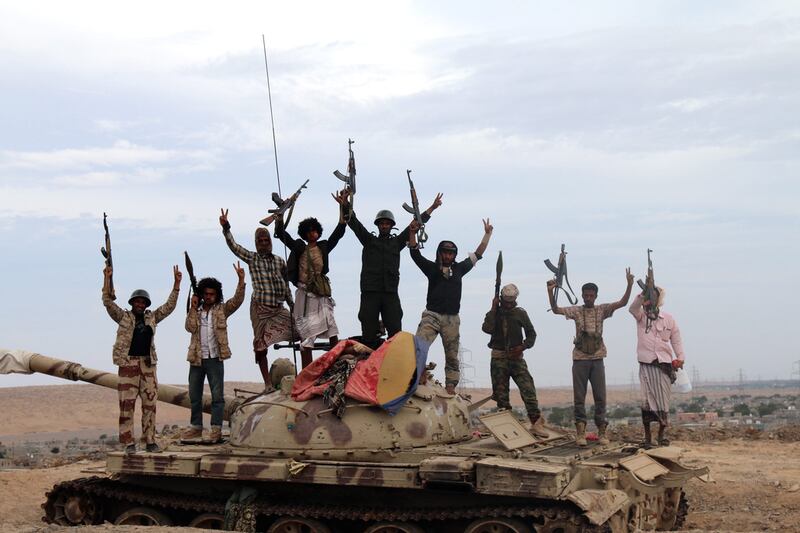A few days ago, Sheikh Mohammed bin Zayed, the Crown Prince of Abu Dhabi and Deputy Supreme Commander of the Armed Forces, met with Saudi King Salman in Riyadh. Other GCC notables were in attendance but the focus must be the relationship between the UAE and Saudi Arabia and what to do about Iran and Yemen in the immediate future. There is also the question of Egypt.
The UAE and Saudi Arabia are keen on coordinating on what appears to be a coming deal between Iran and the world over Tehran’s nuclear file. The P5+1 agreement is of enormous concern to the Emirates and Saudi because of the ramifications for security and politics on the Arabian Peninsula. That Iran is perceived to have now conquered Iraq, Syria and a good chunk of Lebanon is considered a serious matter in terms of regional relations. And now the Houthis, an Iranian proxy, are calling the shots in Yemen.
Iranian perfidy in backing the Houthis is obvious in a few key ways. First, the statements of Iranian clerics close to the Iranian Revolutionary Guard Corps (IRGC). They echo the usual rhetoric about spreading Iran’s revolutionary values. Ali Shirazi, representative of supreme leader Ayatollah Ali Khamenei to the IRGC Quds Force, has said that “Hizbollah was formed in Lebanon as a popular force like Basij (Iran’s militia). Similarly popular forces were also formed in Syria and Iraq, and today we are watching the formation of Ansarollah in Yemen”. Such language, on the eve of a possible agreement on Iran’s nuclear programme, is perceived as a direct threat to the Gulf monarchies. In a sense, it means a Tehran-backed grip on the Peninsula.
The second, and possibly more important proof of Iranian perfidy is their direct contact with the Houthis. Often enough, the 2013 Jihan 1 affair is cited as an example of Tehran's material support for the Houthis. Jihan 1 was a ship filled with Iranian-made weapons and destined for the Houthis. There is other evidence too, including visits to Tehran by Houthi leaders and to Lebanon to meet Hizbollah. Some sources allege that Hizbollah military advisers are on the ground in north Yemen. Though hard to substantiate, it would not be too much of a surprise if it were true.
To the Arab states, the Houthis are a regional threat, which could become a global problem. If left unchecked, they could choke off the Red Sea’s trade routes.
But despite the urgency and significance of the Houthis’ advance, Sheikh Mohammed’s visit to Riyadh was about more than Iran and Yemen. It was also tied in with UAE-Saudi unity concerning Egypt and the way ahead after the Egyptian investment conference in Sharm El Sheikh. There has been some speculation of a rift of sorts over Egypt and there are reports that King Salman does not like Egyptian president Abdel Fattah El Sisi. But these accounts – and the sources who offer them – are suspect. It’s worth noting that almost immediately after King Abdullah’s death and the smooth transition to King Salman, media outlets prone to the Muslim Brotherhood point of view started to disseminate their own narratives. There is every reason to read this as a way to drive a wedge between the UAE and Saudi perhaps in an attempt to weaken the united front against the Brotherhood. Both Riyadh and Abu Dhabi have the Muslim Brotherhood on terrorist watch lists.
A possible remedy to the Yemen problem, which is now a truly catastrophic, multi-dimensional civil war, is to shore up Saudi Arabia’s southern border. Last week, Riyadh tried to get Pakistan to deploy more soldiers but visiting Pakistani prime minister Nawaz Shari felt that a direct confrontation with Iran’s Houthi clients would create a massive problem between Islamabad and Tehran.
But attempts to contain the security crisis in Yemen continue. This is also the context of Sheikh Mohammed’s visit to Morocco to meet King Mohammad VI. The wide ranging discussions focused on ways to contain the maelstrom using a mix of Arab forces that would include Moroccan troops.
These developments underline a growing sense that Arab states must have a security force to deal with land-based threats. In February, president El Sisi called for an Arab force and there have been rumours for months that an Arab military alliance is in prospect. This would mean rapid reaction forces backed by air power to deal with contingencies in the Mena region. Both the UAE and the Saudis are already supporting the Egyptians as they try to stabilise Libya in order to secure the southern part of the Mediterranean littoral. Now, Yemen has become an even bigger challenge given its proximity.
Perhaps what we are really witnessing is the tentative birth of a new regional security pact. It is clear that events in the region, especially Iran’s actions and the growing extremist threat warrant a regional approach that would include military action. This is the unique context of that meeting of GCC leaders and the discussions between the UAE and Saudi Arabia about a military and defence solution to pressing issues in the neighbourhood.
Dr Theodore Karasik is a Dubai-based analyst on the Gulf with a specific focus on Saudi Arabia





